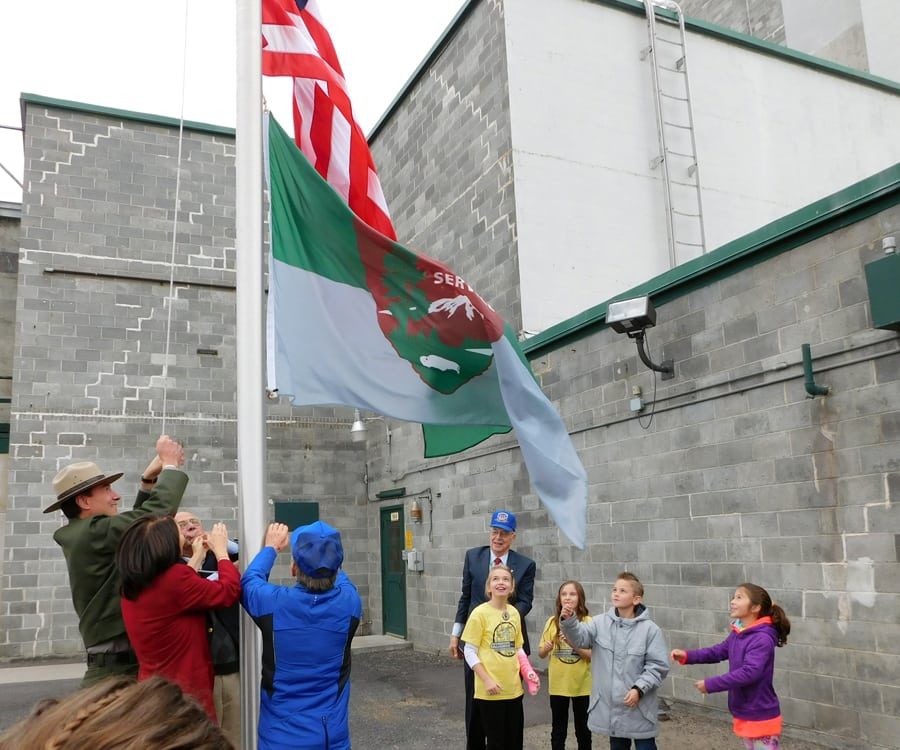
Home » Hanford’s B Reactor site dedicated as part of new national park
Hanford’s B Reactor site dedicated as part of new national park

January 10, 2016
A new flag is now flying over Hanford’s B Reactor. It’s the flag of the National Forest Service, signifying Hanford’s inclusion as one of the three sites creating the new Manhattan Project National Historical Park.
[blockquote quote="This is where the nuclear age began. It’s important to preserve it for the future." source="Doc Hastings, former U.S. representative" align="right" max_width="300px"]
The other two sites that are part of the National Park are Los Alamos, N.M., and Oak Ridge, Tenn., which during World War II, also contributed to research into the new science of atomic energy.
Nearly 300 public officials, former Hanford workers and others gathered at the front face of the deactivated B Reactor National Historic Landmark in November for the dedication ceremony marking Hanford’s inclusion as part of the Manhattan Project National Historical Park. Among the crowd were fourth graders from White Bluffs Elementary School in Richland.
The students were the first youths under the age of 12 allowed to visit B Reactor. Before coming under the umbrella of the National Park Service, only those 12 and older were allowed to tour the facility.
Also attending the ceremony were several founding members of the B Reactor Museum Association.
The group worked tirelessly for more than a decade to obtain public access to the historic site and save the B Reactor, the world’s first full sized nuclear reactor, said Colleen French. French is the program manager for the Manhattan Project National Historical Site and a Department of Energy employee.
The Manhattan Project National Historical Park became the 409th park in the National Park Service’s system on Nov. 10. That’s the day Interior Secretary Sally Jewell and Secretary of Energy Ernest Moniz signed the agreement making the National Park Service and the Department of Energy partners overseeing the new park.
“I don’t have to tell any of you what an amazing opportunity this is,” French said during the dedication. “(The National Park Service) is the gold standard. They are the best in the business and we’re thrilled to have them here. Because, as you all know, the DOE is not in the business of parks and museums.”
The park will be managed as a partnership between the National Park Service and the Department of Energy. The DOE owns the land and buildings while the park service will provide the interpretative center, visitor information and help preserve the buildings and other artifacts. At Hanford, the former town site of White Bluffs will be included in the National Park.
They’re part of the story, said French. The town’s residents were forced to give up their farms, businesses and homes when the government seized their property to create the Hanford site.
More than 51,000 workers at Hanford constructed and operated a massive industrial complex to fabricate, test and irradiate uranium fuel and chemically separate out plutonium.
“Only a handful of workers knew what they were creating,” said French.
B Reactor was built in 11 months and used to produce plutonium used in the world’s first atomic explosion, a test in the New Mexico desert, and in the bomb dropped on Nagasaki, Japan, that helped end World War II.
“This is where the nuclear age began. It’s important to preserve it for the future,” said Doc Hastings during the dedication. For years, Hastings, a former U.S. representative and Sen. Maria Cantwell worked to get B Reactor named as a historic site and included in the Manhattan Project National Historical Park.
Hanford is an important part of the trio of sites that make up the Manhattan Project National Historical Park. The new park, even as spread across the country as it is, tells the story of how the Manhattan Project ushered in a new era of scientific discovery, said Chip Jenkins, acting director of the National Park Service Pacific West Region. He’s responsible for all the national parks in Washington, Oregon and Idaho.
“Of the three sites, Hanford is the can-do site. Hanford is the place where a massive amount of scientific research and technological innovation was brought together and implemented. It’s where theory met practical reality,” said Jenkins, during the dedication.
However, all three sites are incredibly important. Each tells a unique story of its own, and together, the sites tell the story of an incredible period of American history and about the development and utilization of the atomic bomb, said Jenkins.
“There are deep stories here — deep lessons to be learned. The park service is committed to telling the complete and complex story of the Manhattan Project including the impact of the use of nuclear weapons and the remaining ethical questions,” Jenkins said.
The park service has already reached out to the Japanese government to include the stories of those who suffered the devastation created when the two atomic bombs were dropped on their country.
Jenkins said that moving forward, the park service will work with the three communities in the new park to develop a plan for access and operations at all three sites. The agency will also seek input from the public.
“There will be a park service superintendent, but that person will be based in Denver, Colo.,” Jenkins said. “There will be a site manager at all three locations and, if budget permits, we will be setting up additional staff with additional expertise. One of the primary services of the site manager will be to continue to nurture and grow the partnerships that are already in place.”
The National Park Service estimates it will take about two years to complete plans for the park and another three to five before the sites are prepared for public visits. However the DOE already offers tours of the B Reactor and the former White Bluffs’ town site on a seasonal basis.
“If we can establish some type of climate control in B Reactor we’ll be able to offer tours year round, which will be good for the schools,” Jenkins said.
Currently B Reactor has neither air conditioning nor heat.
Free B Reactor National Historic Landmark Tours are offered April through September.
Registrations are accepted by internet or phone. The four-hour tours will be on a Department of Energy sponsored bus.
The DOE also offer tours of the pre-Manhattan Project landmarks at the same time. They include the Hanford High School in the town of Hanford and the Hanford Construction Camp Historic District, Bruggermann’s Agricultural Warehouse Complex, the White Bluffs Bank and the Hanford Irrigation District Pump House.
[panel title="More Information" style="info"]
More tour information is available at manhattanprojectbreactor.hanford.gov. For more information about the Manhattan Project National Historical Park, go to www.nps.gov.
Year in Review
KEYWORDS december 2015 hanford





